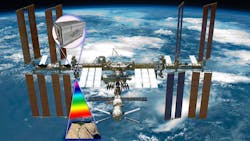Collimator and interferometric alignment system enable environmental monitoring from the ISS
A motorized ultraviolet-visible-near-infrared (UV-Vis-NIR) collimator and interferometric alignment system supplied by optical components and systems producer Optical Surfaces (Kenley, UK) to the Deutsches Zentrum für Luft- und Raumfahrt (DLR) in Berlin, Germany was used to set up the DLR Earth Sensing Imaging Spectrometer (DESIS), a hyperspectral Earth-observation instrument now functioning on-board the International Space Station (ISS).
On 23 October 2019, DLR the renowned German Aerospace Center, and the U.S. company Teledyne Brown Engineering (TBE) announced the start of routine operations for DESIS on the ISS. Operated by DLR and TBE, DESIS is the most powerful hyperspectral Earth observation instrument in orbit and addresses a wide range of applications. Its high-resolution image data will enable the development of measures for environmental protection and support more-efficient ecological use of agricultural land.
The DESIS instrument provides images with a one-of-a-kind level of quality. The sensor system collects image data in 235 closely spaced spectral bands from on board the International Space Station (ISS) at an altitude of 400 km. It has a ground resolution of 30 m and a spectral resolution of 2.55 nm. This significantly increases the depth of information available in Earth-observation data. The first images were acquired shortly after initial setup, and DESIS data has already been used to identify plastic "islands" and oil slicks at sea. A few months ago, the high spatial resolution of DESIS made it possible to detect rare-Earth elements from space for the first time.
Ilse Sebastian, a calibration engineer at DLR, says, "By installing the motorized UV-Vis-NIR collimator and interferometric alignment system in our class 100,000 clean room, we have been able to undertake diffraction-limited broadband imaging for MTF measurement, focusing, and geometric calibration of single optics and focal planes, fully integrated camera systems, and hyperspectral imaging systems such as DESIS. To monitor and verify that the UV-Vis-NIR collimator system is consistently in alignment, Optical Surfaces also designed and supplied a software-operated laser unequal path-length interferometer (LUPI) system to interface with the collimator system."
For further information on Optical Surfaces, see www.optisurf.com.
For further information relating to the Institute of Optical Sensor Systems at Deutsches Zentrum für Luft- und Raumfahrt (DLR), see https://www.dlr.de/os.
Source: Optical Surfaces

John Wallace | Senior Technical Editor (1998-2022)
John Wallace was with Laser Focus World for nearly 25 years, retiring in late June 2022. He obtained a bachelor's degree in mechanical engineering and physics at Rutgers University and a master's in optical engineering at the University of Rochester. Before becoming an editor, John worked as an engineer at RCA, Exxon, Eastman Kodak, and GCA Corporation.
